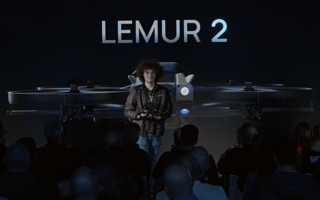In June 2021, Blake Resnick got a call from Surfside, Florida. First responders were on the scene of a partially-collapsed condominium building and needed support as concerns lingered about the rest of the building collapsing.
Resnick, the CEO and founder of BRINC, had the tools to help. The LEMUR drone aided first responders in evaluating the remainder of the building and deciding to manage the recovery mission and its eventual controlled demolition.
A year later, BRINC donated almost 50 LEMUR systems to Ukrainian emergency responders surveying buildings hit by cruise missiles.
And earlier this spring, the team sent personnel and equipment to Turkey as the nation mounted a massive response to the 7.3 magnitude earthquake that struck southern Turkey and Syria.
Since building the first LEMUR prototype in his mother’s kitchen in 2018, Resnick has grown the company to a 100-person team supporting 400 public safety agencies around the world. And now, the next generation of BRINC’s drone — the LEMUR 2 — is debuting to pursue the mission.
Built In heard from Resnick about his journey building BRINC and the possibilities LEMUR 2 offers.

What led you to found BRINC? How did your early products develop?
On October 1, 2017, I got a call from my best friend. He told me that he started hearing gunshots along the Las Vegas Strip and asked me where I was. Over the next couple of hours, I learned that the deadliest mass shooting in American history had just occurred in my hometown. As it did for many in my community, this event changed my life. I started thinking about the place for modern technology in the hands of first responders to help them respond to these kinds of events.
Eventually, I got in contact with the Las Vegas Metropolitan Police Department and through to some folks on the SWAT team. Amazingly, they agreed to have lunch with me, and we spoke about the events of October 1 and the high-risk situations they encounter on the job. I walked away from that meeting thinking that if they had a tool to get eyes and ears in places that would be dangerous to send a person, the capability could save lives across a wide array of emergency response missions.
So, I went back to my mom’s kitchen and started engineering the first versions of what became the LEMUR drone.
“I went back to my mom’s kitchen and started engineering the first versions of what became the LEMUR drone.”
How did you first get products in the hands of first responders? What was the initial response?
After a couple months, I had a version of the LEMUR that I was proud of, so I reached back out to the SWAT team. I went to the meeting with high hopes but lost the audience almost immediately. Early in the demo, I was flying the drone around when one of the officers grabbed a towel, walked up to the aircraft in mid-air and slapped it out of the sky in front of the crowd. It landed on its back, and he explained to me that this would happen in the first five minutes of their first SWAT callout. Without the ability to flip itself over and take back off, the drone would be a worthless tool.
It was a brutal way to learn, but I went back excited to totally re-engineer this drone. When I had something decent, I reached back out, and the SWAT commander said they’d be interested in testing it on some live SWAT callouts.
That started an interesting six-month period of my life where I went on call with Vegas Metro SWAT. The beginning was a learning experience, but by the end, we started affecting these SWAT callouts by looking around inside a structure and using the two-way audio system.
The drone has been used on many thousands of SWAT callouts all over the world. Along the way, we found that this is a tool useful for more than tactical response, as we see from experience in Surfside, Ukraine and Turkey.

What features are you most excited to see in use with the release of LEMUR 2?
LEMUR 2 is the first product with BRINC’s autonomy engine, so this is a fundamental software platform that a lot of our more advanced features are built on.
The LEMUR 2 has full position holds, which means you can park it anywhere in the sky and take your hands off the sticks — it’ll hold in that position for any amount of time. What’s unique and important about this function is that it works in GPS-denied conditions and in zero-light conditions. So no matter where you are, position-hold will be robust.
Additionally, as you’re clearing a building with LEMUR 2, it’s generating a 3D point cloud. You can view in 3D or 2D to get floor plans and really understand what you’re about to enter. Our LiDAR sensor also powers smart-speed obstacle awareness. Instead of blocking you completely from entering environments with obstacles, we have the drone slowed down so it’ll prevent you from crashing at high speed but still allow you to nose your way in places that you might want to explore.
Another feature I’m extremely excited about is our capability to mesh-network drones, controllers and even body-worn radios. In a situation where you have to clear a large building, there can be a dozen walls between you and the aircraft, making it hard to get a signal through. With this, you can send one bird a third of the way in and perch it. That will then act as a signal repeater that allows you to send further birds deeper into the structure. This also works really well in subterranean environments so you can actually explore where you need to without worrying so much about signal penetration.
Frankly, that is just scratching the surface of the upgrades we have made from LEMUR, and critically, all of this hardware is built here in our American facilities and all of the electronics on board are sourced from the U.S. and our partners.









.jpg)
.png)